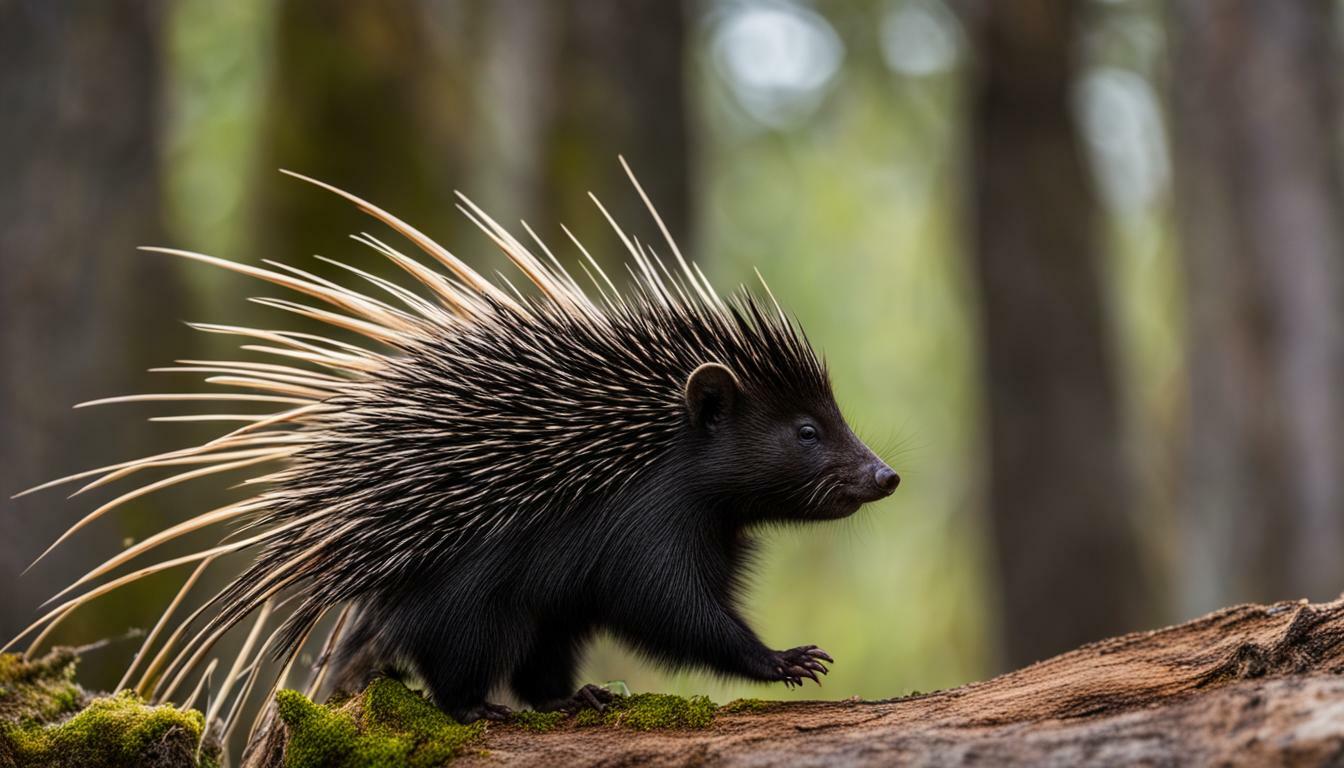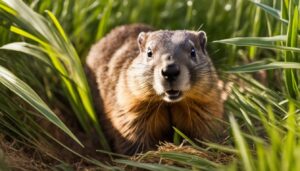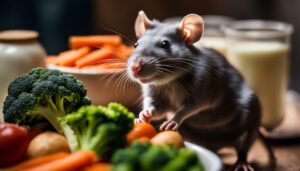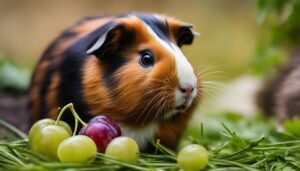Porcupines are fascinating North American wildlife creatures, but have you ever wondered if they are poisonous?
Key Takeaways:
- Porcupines are not poisonous but can cause injuries with their sharp quills.
- If quilled, seeking medical help is essential for safe removal of the quills.
- Quills have barbs that make them difficult to remove and can cause serious tissue damage and infections if left in the skin.
- Porcupines generally do not attack humans unless they feel threatened.
- Encounters with porcupines can be fatal for small pets like dogs and cats if not treated immediately.
Porcupine Quills: Sharp but Not Venomous
While porcupines possess sharp quills, they are not venomous and do not inject poison into their victims. These quills are modified hairs that serve as a defense mechanism for the porcupine. When threatened, the porcupine can raise and rattle its quills, warning potential predators to keep their distance.
Porcupine quills may be sharp, but they are not designed to be venomous. However, they can cause injuries if they come into contact with humans or pets. If you or your pet are quilled, it is crucial to seek medical help for safe removal. The quills have barbs that make them difficult to remove, and if left in the skin, they can cause serious tissue damage and even lead to infections.
It is important to note that porcupines do not attack humans unless they feel threatened. It’s best to admire these intriguing creatures from a safe distance and avoid touching them. While they may not pose a significant threat to humans, encounters with porcupines can be particularly dangerous for small pets like dogs and cats. If your pet gets quilled, immediate treatment is essential to prevent further complications and potential fatalities.
| Porcupine Quills: Sharp but Not Venomous | |
|---|---|
| Porcupine quills are not venomous and do not inject poison into their victims. | These quills serve as a defense mechanism for the porcupine. |
| Quills have barbs that make them difficult to remove, and if left in the skin, they can cause serious tissue damage and infections. | Seek medical help for safe removal if you or your pet are quilled. |
| Porcupines do not attack humans unless they feel threatened, but they can be dangerous to small pets like dogs and cats. | Immediate treatment is crucial to prevent fatal consequences for pets. |
Safety Tips Around Porcupines
To avoid any unwanted encounters with porcupines, it is important to be aware of some safety precautions. While porcupines are generally not aggressive towards humans, they can become defensive if they feel threatened. Here are some safety tips to keep in mind when in porcupine habitats:
- Keep a safe distance: Porcupines have sharp quills that can cause painful injuries. It is best to admire them from a distance and avoid approaching too closely.
- Stay quiet and calm: Loud noises or sudden movements can startle a porcupine, triggering a defensive response. Keep your voice low and avoid making sudden gestures.
- Avoid touching or petting: Porcupines may seem cute, but their quills are not meant for cuddling. Resist the temptation to touch or pet a porcupine, as this can result in quill injuries.
- Leash and supervise pets: If you are walking your dog in a porcupine habitat, keep them on a leash and under close supervision. Dogs are often curious about porcupines and can easily get quilled if they try to investigate.
- Be cautious at night: Porcupines are nocturnal creatures, so be extra vigilant when exploring their habitats after sunset. Use a flashlight to help detect their presence and avoid accidental encounters.
Porcupine Predators
In addition to following these safety tips, it is important to be aware of the predators that pose a threat to porcupines. While their sharp quills provide effective defense mechanisms against most predators, there are a few creatures that have learned to overcome this obstacle. Some common porcupine predators include:
| Predator | Adaptations |
|---|---|
| Bobcats | Bobcats have developed the skill to flip porcupines onto their backs, exposing the quill-free underbelly. |
| Coyotes | Coyotes have learned to attack from the front, avoiding the majority of the quills located on the porcupine’s back. |
| Fishers | Fishers are particularly adept at attacking porcupines. They target vulnerable areas such as the face and belly, minimizing quill injuries. |
By staying cautious and respecting the boundaries of these fascinating creatures, you can ensure a safe and enjoyable experience when encountering porcupines in their natural habitats.
The Defense Mechanisms of Porcupines
Porcupines have developed remarkable defense mechanisms that make them a formidable opponent. Their most well-known defense mechanism is their sharp quills that cover their bodies. These quills are not venomous, but they serve as an effective deterrent against potential predators. When threatened, porcupines erect their quills, making themselves appear larger and more dangerous.
The quills themselves have barbs that make them difficult to remove once they become embedded in an attacker’s skin. This means that predators, such as coyotes or mountain lions, who attempt to attack a porcupine may end up with a face or mouth full of painful quills. The quills can cause serious tissue damage and lead to infections if not properly treated.
In addition to their quills, porcupines have other defense mechanisms that aid in their survival. Their slow movement and tendency to climb trees make it challenging for predators to catch them. Porcupines can also make use of their strong hind legs and sharp claws to strike at potential threats. By combining these defense mechanisms, porcupines have become masters at protecting themselves from harm.
| Porcupine Defense Mechanisms | Porcupine Evolutionary Adaptations |
|---|---|
| Sharp quills that deter predators | Erecting quills to appear larger and more dangerous |
| Quills with barbs that cause pain and difficulty in removal | Slow movement and climbing ability |
| Capability to strike with strong hind legs and sharp claws | Survival through a combination of defense mechanisms |
It’s important to note that while porcupines may seem intimidating, they typically only attack when they feel threatened. It’s best to avoid touching or provoking them to prevent any potential injuries. However, if you or your pet does get quilled, it is crucial to seek immediate medical attention to have the quills safely removed. Prompt treatment can help prevent further complications and ensure a quick recovery.
When it comes to small pets like dogs or cats, encounters with porcupines can be particularly dangerous. The quills can cause severe pain and injury, and if left untreated, they can lead to life-threatening situations. If your pet gets quilled, it is essential to seek veterinary assistance as soon as possible. Veterinarians have the necessary tools and expertise to safely remove the quills and provide the appropriate treatment for your pet’s well-being.
Porcupines and Humans: Minimal Threat
While porcupines may seem intimidating, they typically pose little threat to humans. It’s important to remember that porcupines are not aggressive creatures and will only attack if they feel threatened or cornered. Therefore, it’s best to avoid any direct contact with them to prevent any potential harm.
However, it’s crucial to be cautious when encountering porcupines, especially if you have small pets like dogs or cats. These spiky creatures have developed effective defensive mechanisms to protect themselves from predators, and their quills can cause serious injuries. If your pet comes into contact with a porcupine and gets quilled, it is essential to seek immediate veterinary care to minimize any potential complications.
When it comes to humans, porcupine quills can cause painful puncture wounds. The quills have barbs that make them difficult to remove, and attempting to do so without proper medical assistance can lead to further tissue damage and the risk of infections. Therefore, if you or someone you know gets quilled, it’s crucial to seek medical help to have the quills safely removed and to receive appropriate treatment.
Table: Safety Tips for Encounters with Porcupines
| Tips | Description |
|---|---|
| Avoid direct contact | Keep a safe distance from porcupines to reduce the risk of injury. |
| Keep pets on a leash | Prevent your pets from approaching porcupines and potentially getting quilled. |
| Stay calm and quiet | Avoid sudden movements or loud noises that may startle the porcupine. |
| Back away slowly | If you find yourself near a porcupine, slowly walk away to give it space. |
Remember, porcupines are fascinating and harmless creatures when left undisturbed. By following these safety tips and respecting their space, you can peacefully coexist with these unique creatures in their natural habitat.
Treating Quill Injuries
If you or your pet encounter a porcupine and end up with quills, it is crucial to know the proper steps for treatment. Although porcupines are not venomous, their quills can cause injuries due to their sharpness and barbs.
Here are some essential tips for treating quill injuries:
- Seek medical help: It is important to consult a healthcare professional or veterinarian to have the quills safely removed. Quills have barbs that make them difficult to pull out on your own, and attempting to do so can cause more harm.
- Prevent complications: Leaving quills embedded in the skin can lead to serious tissue damage and increase the risk of infections. Prompt medical attention will help minimize these complications.
- Avoid touching the quills: Porcupine quills are sharp and can easily penetrate the skin. It is best to avoid touching them directly to prevent accidental injuries.
Remember that porcupines do not attack humans unless they feel threatened. However, they can pose a significant danger to small pets like dogs and cats. If your pet gets quilled, it is crucial to seek immediate treatment to prevent further harm. Quills can cause severe pain and discomfort to pets, and if not treated promptly, they can lead to life-threatening situations.
| Injury Treatment | Importance |
|---|---|
| Seek medical help | Quill removal by professionals ensures safety and minimizes further harm. |
| Prevent complications | Removing quills promptly reduces the risk of tissue damage and infections. |
| Avoid touching the quills | Direct contact with quills can result in accidental injuries. |
By following these guidelines and seeking immediate medical assistance, you can ensure the proper treatment of quill injuries and promote a speedy recovery for both you and your beloved pets.
Porcupines and Pets: A Deadly Combination
Porcupines can pose a serious threat to our furry friends, and quick action is essential to ensure their safety. While porcupines are generally docile creatures, they have a highly effective defense mechanism that can cause severe harm to pets. Their quills, which are sharp and barbed, can easily penetrate the skin of an unsuspecting animal, leading to painful injuries.
If a pet encounters a porcupine and gets quilled, immediate veterinary attention is crucial. Attempting to remove the quills at home can cause further harm and complications. The barbs on the quills make them difficult to remove, and if left embedded in the skin, they can lead to serious tissue damage and infections.
When seeking professional help, veterinarians have specialized tools and techniques to safely remove the quills without causing additional pain or harm to the pet. They can also provide pain relief and antibiotics if necessary to prevent infections. Time is of the essence when dealing with quilled pets, as the longer the quills remain in the skin, the higher the risk of complications.
Signs of a quilled pet:
- Pain and discomfort
- Excessive drooling or pawing at the mouth
- Swelling or redness around the affected area
- Reluctance to eat or drink
- Limping or favoring a specific leg
It’s important to keep a close eye on pets, especially in areas where porcupines are known to inhabit. Avoid letting pets roam off-leash in porcupine-prone areas, and if possible, keep them indoors during dawn and dusk when porcupines are most active.
Remember, the safety of our pets relies on our vigilance and quick action. By being aware of the dangers of porcupine encounters and seeking immediate veterinary help if a pet gets quilled, we can prevent potentially fatal consequences for our beloved furry companions.
| Signs of a Quilled Pet: | Actions to Take: |
|---|---|
| 1. Pain and discomfort | Schedule a veterinary appointment immediately. |
| 2. Excessive drooling or pawing at the mouth | Do not attempt to remove quills yourself. Seek professional help. |
| 3. Swelling or redness around the affected area | Keep the pet calm and prevent further irritation. Contact a veterinarian for advice. |
| 4. Reluctance to eat or drink | Monitor the pet closely and seek veterinary assistance if symptoms persist. |
| 5. Limping or favoring a specific leg | Refrain from touching the quills and take the pet to a veterinarian for proper treatment. |
The Unique Nature of Porcupines
Porcupines are fascinating creatures with a range of distinctive qualities that set them apart from other North American wildlife. These herbivorous rodents have long been admired for their impressive evolutionary adaptations, making them capable of surviving in a variety of habitats.
One of the most iconic features of porcupines is their quills. These sharp, needle-like structures serve as a vital defense mechanism against predators. Contrary to popular belief, porcupine quills are not venomous. However, their barbed nature makes them incredibly difficult to remove once embedded in the skin. In fact, attempting to pull out the quills can cause further damage, as their barbs can become lodged deeper into the body.
When encountering a porcupine, it is crucial to maintain a safe distance and avoid any physical contact. While porcupines are typically docile creatures, they may feel threatened if approached or startled. It is important to note that porcupines do not attack humans unless provoked or cornered.
While porcupines pose minimal threat to humans, they can be extremely dangerous to small pets like dogs and cats. Encounters with porcupines can be fatal for pets if not promptly addressed. The quills can cause severe pain, tissue damage, and even infection if left untreated. If your pet is quilled, it is essential to seek immediate veterinary assistance for safe and proper quill removal.
| Porcupine Facts | |
|---|---|
| Scientific Name | Erethizon dorsatum |
| Habitat | Porcupines can be found in a wide range of habitats, from forests and grasslands to deserts and mountains. They are primarily found in North America, with some species present in South America and Africa. |
| Diet | Porcupines are herbivores, feeding on a variety of plant materials such as bark, twigs, leaves, and fruits. They have strong jaw muscles and specialized teeth that allow them to gnaw on tough vegetation. |
| Physical Characteristics | Porcupines are covered in quills that are sharp and bristly. These quills are actually modified hairs that are coated with a layer of keratin. They come in various lengths and are often vibrantly colored. |
Quirks and Abilities of Porcupines
Beyond their defensive capabilities, porcupines possess a variety of other intriguing traits. These spiky creatures are known for their excellent climbing skills, aided by their strong claws and prehensile tail. Porcupines can effortlessly navigate trees and branches, making them highly adapted to arboreal lifestyles. They are also skilled swimmers, using their buoyant bodies and paddle-like tails to move through water with grace.
In addition to their remarkable agility, porcupines are known for their exceptional senses. Their highly developed sense of smell allows them to efficiently locate food sources, while their keen hearing helps them detect potential predators or threats. Porcupines also have a strong sense of touch, which is vital for their defense mechanism. By sensing changes in pressure, they can effectively release their quills when they feel threatened.
Quills: An Adaptive Defense Mechanism
The most notable characteristic of porcupines is undoubtedly their quills. These modified hairs play a crucial role in protecting the porcupines from predators. Contrary to popular belief, porcupines cannot shoot or throw their quills, but the barbed structure of the quills makes them difficult to remove once embedded in the skin of an attacker.
The quills of a porcupine are coated with a waxy substance and have microscopic barbs that facilitate their attachment to the attacker’s skin. This defense mechanism serves as a painful deterrent, ensuring that predators think twice before attempting to make a meal out of these prickly creatures.
To give you an idea of the extent of their defenses, consider the fact that a porcupine can have as many as 30,000 quills on its body. The quills cover most of its back, sides, and tail, acting as a formidable line of defense against potential threats.
| Quill Facts |
|---|
| Porcupines have hollow quills that are as sharp as needles. |
| The quills vary in length, ranging from 2 to 4 inches. |
| Quills are predominantly found on the back, sides, and tail of the porcupine. |
| A porcupine can have as many as 30,000 quills. |
Porcupine Habitats and Distribution
Porcupines have managed to thrive in diverse habitats across North America. These fascinating creatures can be found in various regions, from wooded areas and forests to deserts and grasslands. They have adapted to withstand a wide range of climates and environmental conditions, making them highly adaptable and successful in their distribution.
One of the reasons for the widespread distribution of porcupines is their ability to consume a variety of plant material. They are known to feed on bark, leaves, twigs, and even fruits, allowing them to survive in different ecosystems. This dietary flexibility contributes to their ability to inhabit various habitats, from coniferous forests to arid desert landscapes.
In North America, porcupines can be found in regions such as the Northeastern United States, the Great Lakes area, the Rocky Mountains, and parts of the Southwest. They are also present in parts of Canada, including the provinces of Ontario, British Columbia, and Alberta.
| Habitat | Distribution |
|---|---|
| Forests | Northeastern United States, Great Lakes region |
| Mountains | Rocky Mountains |
| Deserts | Southwest United States |
| Grasslands | Various regions in North America |
| Wooded Areas | Parts of Canada (Ontario, British Columbia, Alberta) |
Adaptation to Different Habitats
Porcupines have evolved certain traits that enable them to thrive in their respective habitats. For example, their sharp quills provide protection against predators in wooded areas, where they often seek refuge in trees. In contrast, porcupines in open grasslands rely more on their excellent camouflage and ability to burrow for survival.
Their distribution across such a wide range of habitats is a testament to their adaptability and resilience as a species. By understanding their preferred habitats and distribution patterns, we can better appreciate the incredible diversity and survival strategies of these unique creatures.
Porcupine Conservation Efforts
Conserving porcupine populations is crucial for preserving the natural balance of our ecosystems. These fascinating creatures play a vital role in maintaining the health and diversity of their habitats. As we continue to understand more about their behavior and unique adaptations, it becomes increasingly important to protect and conserve them.
One key aspect of porcupine conservation is the preservation of their natural habitats. Porcupines are found in a variety of environments, including forests, grasslands, and deserts. By safeguarding these habitats from deforestation, urbanization, and other human-induced activities, we ensure that porcupines have the necessary space and resources to thrive.
Efforts to conserve porcupines also involve educating the public about the importance of coexisting with these creatures. By understanding their behaviors and natural instincts, we can minimize human-wildlife conflicts and prevent unnecessary harm to porcupines. This includes educating pet owners about the dangers of porcupine encounters and providing guidance on how to safely remove quills in case of an unfortunate incident.
Conservation Strategies:
- Protecting porcupine habitats from deforestation and habitat destruction.
- Implementing measures to minimize human-wildlife conflicts and mitigate risks to porcupines.
- Strengthening legislation and regulations to prevent illegal hunting and poaching of porcupines.
- Supporting research and monitoring efforts to gather data on porcupine populations and better understand their ecological role.
- Educating the public on the importance of porcupines and their conservation through awareness campaigns and community engagement.
By implementing these conservation strategies and fostering a harmonious relationship between humans and porcupines, we can ensure the long-term survival of these captivating creatures and contribute to the overall health and resilience of our ecosystems.
| Porcupine Conservation Efforts | Benefits |
|---|---|
| Protecting habitats | Preserves biodiversity and ecosystem balance |
| Minimizing conflicts | Reduces harm to both humans and porcupines |
| Strengthening legislation | Deters illegal hunting and ensures legal protection |
| Supporting research | Advances scientific knowledge on porcupines and their ecological role |
| Educating the public | Fosters awareness and promotes coexistence |
Understanding Porcupines: Fascinating and Harmless Creatures
Porcupines are captivating creatures that inspire both curiosity and caution, but it’s important to remember that they are not poisonous. Despite their sharp quills, porcupines are harmless to humans unless provoked. Their quills are not venomous, but they can cause injuries if touched or stepped on.
When it comes to encounters with porcupines, it’s essential to exercise caution, especially if you have a small pet like a dog or a cat. Porcupines have evolved highly effective defense mechanisms to protect themselves from predators. If your pet gets quilled, it’s crucial to seek immediate veterinary attention to prevent any serious complications.
Removing porcupine quills is not a do-it-yourself task. The quills have barbs that make them difficult to remove, and attempting to do so on your own can lead to further complications. Seeking professional medical help ensures that the quills are safely and efficiently removed, minimizing the risk of tissue damage or infection.
While porcupines generally avoid confrontation and will not attack humans unprovoked, it’s best to maintain a safe distance and avoid touching them. If you encounter a porcupine in the wild, observe it from a distance, appreciating its unique nature without putting yourself at risk.
In conclusion, porcupines are fascinating and harmless creatures that play an important role in our ecosystem. They are not poisonous, but their quills can cause harm if not handled properly. By understanding their behavior and respecting their personal space, we can coexist with these remarkable animals and admire their quirks from a safe distance.
FAQ
Are porcupines poisonous?
No, porcupines are not poisonous. Their quills are not venomous, but they are sharp and can cause injuries.
What should I do if my pet or I get quilled by a porcupine?
It is important to seek medical help to have the quills safely removed. Quills have barbs that make them difficult to remove, and if left in the skin, they can cause serious tissue damage and infections.
Do porcupines attack humans?
Porcupines do not attack humans unless they feel threatened. It is best to avoid touching them to prevent any accidents.
Are porcupines dangerous to small pets?
Yes, encounters with porcupines can be fatal for small pets like dogs and cats if not treated immediately. The quills can cause serious injuries and complications.




